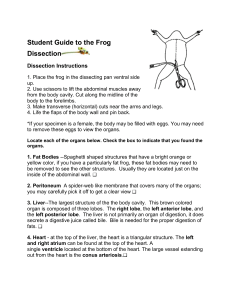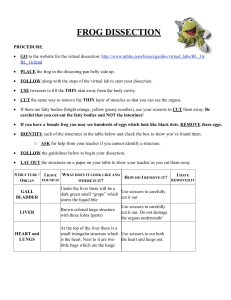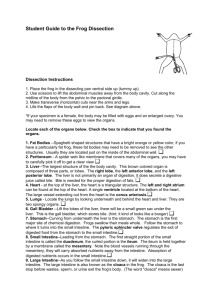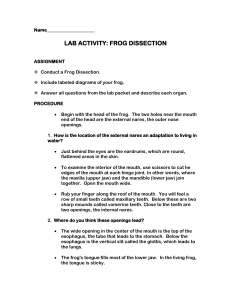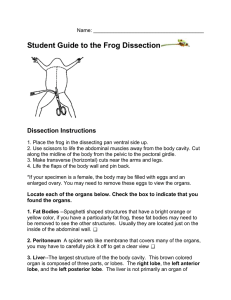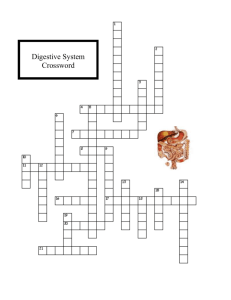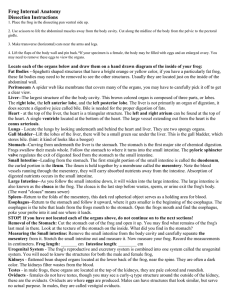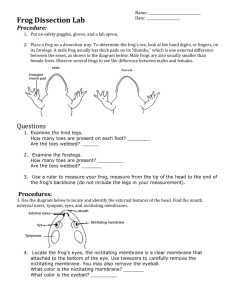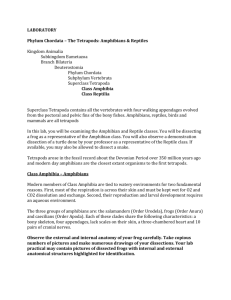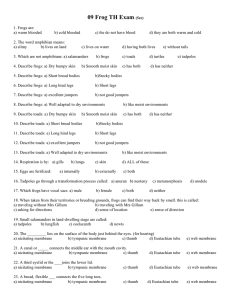Frog Dissection Answer Sheet
advertisement
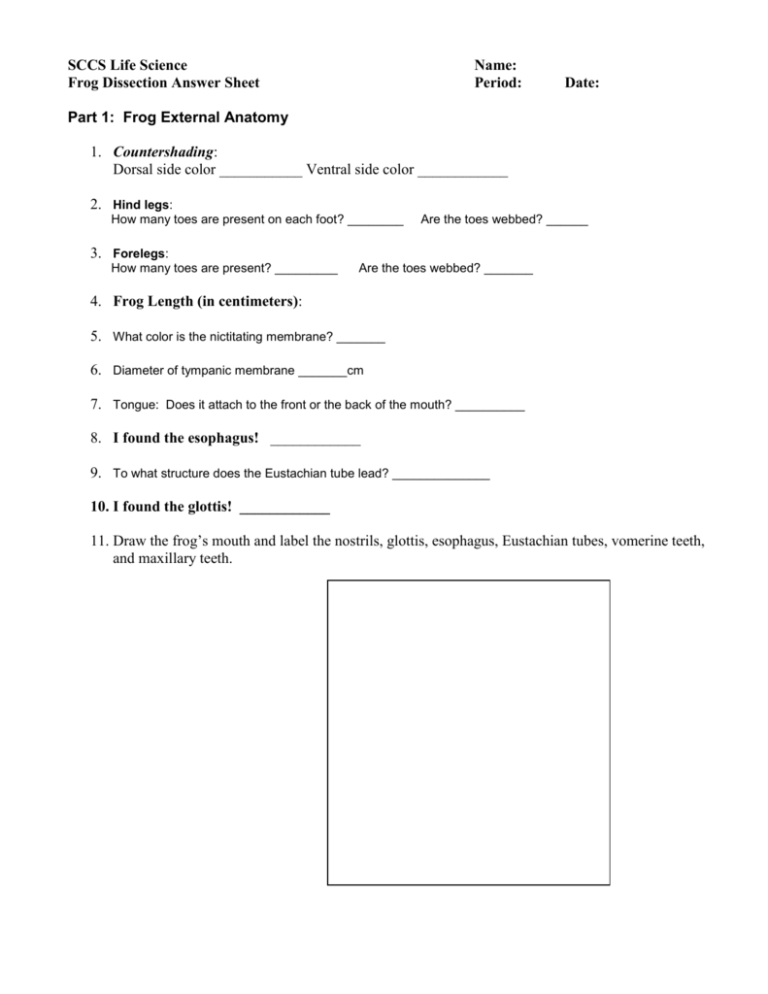
SCCS Life Science Frog Dissection Answer Sheet Name: Period: Date: Part 1: Frog External Anatomy 1. Countershading: Dorsal side color ___________ Ventral side color ____________ 2. Hind legs: How many toes are present on each foot? ________ Are the toes webbed? ______ 3. Forelegs: How many toes are present? _________ Are the toes webbed? _______ 4. Frog Length (in centimeters): 5. What color is the nictitating membrane? _______ 6. Diameter of tympanic membrane _______cm 7. Tongue: Does it attach to the front or the back of the mouth? __________ 8. I found the esophagus! ____________ 9. To what structure does the Eustachian tube lead? ______________ 10. I found the glottis! ____________ 11. Draw the frog’s mouth and label the nostrils, glottis, esophagus, Eustachian tubes, vomerine teeth, and maxillary teeth. Part II: Frog Internal Anatomy Fat Bodies --Spaghetti shaped structures that have a bright orange or yellow color, if you have a particularly fat frog, these fat bodies may need to be removed to see the other structures. Usually they are located just on the inside of the abdominal wall. Peritoneum A spider web like membrane that covers many of the organs, you may have to carefully pick it off to get a clear view Liver--The largest structure of the body cavity. This brown colored organ is composed of three parts, or lobes. The right lobe, the left anterior lobe, and the left posterior lobe. The liver is used to filter toxins out of the blood and for digestion. It produces a digestive juice called bile. Bile is needed for the proper digestion of fats. Heart - at the top of the liver, the heart is a triangular structure. The left and right atrium can be found at the top of the heart. A single ventricle located at the bottom of the heart. The large vessel extending out from the heart is the conus arteriosis. Lungs - Locate the lungs by looking underneath and behind the heart and liver. They are two spongy organs. Gall bladder--Lift the lobes of the liver, there will be a small green sac under the liver. This is the gall bladder, which stores bile. (hint: it kind of looks like a booger) Stomach--Curving from underneath the liver is the stomach. The stomach is the first major site of chemical digestion. Frogs swallow their meals whole. Follow the stomach to where it turns into the small intestine. The pyloric sphincter valve regulates the exit of digested food from the stomach to the small intestine. Small Intestine--Leading from the stomach. The first straight portion of the small intestine is called the duodenum, the curled portion is the ileum. The ileum is held together by a membrane called the mesentery. Note the blood vessels running through the mesentery, they will carry absorbed nutrients away from the intestine. Absorption of digested nutrients occurs in the small intestine. The mesentery is a vessel filled membrane that holds the intestine in place. Large Intestine--As you follow the small intestine down, it will widen into the large intestine. The large intestine is also known as the cloaca in the frog. The cloaca is the last stop before wastes, sperm, or urine exit the frog's body. (The word "cloaca" means sewer) Spleen--Return to the folds of the mesentery, this dark red spherical object serves as a holding area for blood. Esophagus--Return to the stomach and follow it upward, where it gets smaller is the beginning of the esophagus. The esophagus is the tube that leads from the frogs mouth to the stomach. Open the frogs mouth and find the esophagus, poke your probe into it and see where it leads. 12. What did you find in the stomach? __________________________ 13. Describe the inner stomach texture. _______________________ 14. Frog length: _______ cm Intestine length ________ cm Kidneys - flattened bean shaped organs located at the lower back of the frog, near the spine. They are often a dark color. The kidneys filter wastes from the blood. Testes - in male frogs, these organs are located at the top of the kidneys, they are pale colored and roundish. Oviducts - females do not have testes, though you may see a curly-q type structure around the outside of the kidney, these are the oviducts. Oviducts are where eggs are produced. Males can have structures that look similar, but serve no actual purpose. In males, they are called vestigial oviducts. Bladder - An empty sac located at the lowest part of the body cavity. The bladder stores urine. Cloaca - mentioned again as part of the urogenital system - urine, sperm and eggs exit here. 15. Label the male and female urogenital system below. Male Female Post Lab Questions 1. The membrane holds the coils of the small intestine together: ________________ 2. This organ is found under the liver, it stores bile: ______________________ 3. Name the 3 lobes of the liver: ____________, _______________, ______________ 4. The organ that is the first major site of chemical digestion: ____________________ 5. Eggs, sperm, urine and wastes all empty into this structure: ___________________ 6. The small intestine leads to the: ____________________ 7. The esophagus leads to the: _______________________ 8. Yellowish structures that serve as an energy reserve: ____________________ 9. The first part of the small intestine(straight part): _______________________ 10. After food passes through the stomach it enters the: ____________________ 11. A spiderweb like membrane that covers the organs: ______________________ 12. Regulates the exit of partially digested food from the stomach: ________________ 13. The large intestine leads to the __________________ 14. Organ found within the mesentery that stores blood: _____________________ 15. The largest organ in the body cavity: _____________________ 16. Label the picture below.
